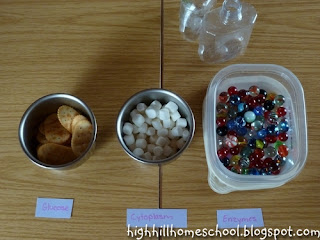For those of you joining me for the first time here's a little background on our current science activities. We are doing an in-depth cell study for science. Over the past seven months we have become familiar with many new words in conjunction with my daughter's Leukemia treatment. Some of which are; white blood cells, red blood cells, platelets, bone marrow biopsy, leukocytes, and neutraphils. With all this going on the timing was just right to study cells for science.
David Macaulay's The Way We Work is the fabulous resource we are using as a guide for our cell activities. Each week I read a few pages in the book and then create an activity to go along with what I read. This week the topic was Energy Breakdown.
Energy breakdown with cells is something like digestion. There are several steps to digestion. Food is smashed by chewing and broken down further in the stomach. It is broken down still further as it works its way through the digestive tract. Within the cells, energy breakdown also happens in several steps.
The above photo shows the items involved in energy production. From left to right.
Glucose represented by crackers
Cytoplasm represented by marshmallows
Enzymes represented by marbles
Cells represented by empty soap bottles
ATP is the output or usable energy which is placed in the empty bowl
Mitochondria Inner Membrane represented by skinny plastic bag
Mitochondria Outer Membrane represented by plastic bag
The first step in energy breakdown happens in the cytoplasm.
The kids filled their cells (plastic bottles) with enzymes (marbles), cytoplasm (marshmallows), and glucose (crackers).
Then they shook their cells to break down the glucose. When they were finished, some of the glucose was turned into ATP or usable energy. The bigger chunks of cracker, or pyruvate were placed into the inner membrane of the mitochondria (tall skinny bag) to be broken down further.
The next step in energy breakdown happens in the mitochondria. The inner membrane is coiled inside the outer membrane.
The kids put the pyruvate (large cracker chunks), and enzymes into the inner membrane of the mitochondria.
The inner membrane was coiled into the outer membrane and then smashed to produce more energy.
The result was more ATP or usable energy.
When we finish up with cells we are moving into the rest of the human body. To see more of our cell and other science activities please visit the science page.

This post is linked to:
Share it Saturday
Show and Tell
Exploring Eastern Cultures with Sonlight by Susan @ Homeschooling Hearts & Minds
Cell Unit Study - Mitochondria and Energy by Julie @ Highhill Education
Our Blended Social Studies by Christy @ Unexpected Homeschool
2013 Virtual Curriculum Fair-Exploring Our World: Social Studies and more Science by Leah C @ As We Walk Along the Road
Exploring Canada by Annette @ A Net In Time
Project Passport: The Middle Ages by Missouri Mama @ Ozark Ramblings
Virtual Curriculum Fair- Exploring Our World by Karyn @ Teach Beside Me
Our Absolutely Positively Favorite History Curriculum Ever by Wendy @ Homeschooling Blessings
Science: learning to use what you are given by Piwi Mama @ Learning & Growing the Piwi Way
Historical Significance by Kristi @ The Potter’s Hand Academy
How We Are Exploring Our World as Homechoolers by Laura O in AK @ Day by Day in Our World
VCF: Week 3 The Social Sciences by Lisa @ Golden Grasses
A Trip Around the World: Homeschool-Style by Nicole @ Schooling in the Sun
Virtual Curriculum Fair ~ Exploring Our World:
Biology by Dawn @ Guiding Light Homeschool
Virtual Curriculum Fair: Learning about our
World by Joelle @ Homeschooling for His GloryScience is Cool by TechWife @ Playground of Words
* I did not receive any compensation for this recommendation. I'm just a homeschooling mom who has found many products that I like. If you're interested in the products I recommend on this blog I want to make it easy for you to find them.
** I am an Amazon associate and receive a small portion of the sales on orders made after clicking in from this site, which I promptly spend on homeschooling books and supplies for my children.











Wow, what a great demonstration of the process of cells and mitochondria's role in that! Mitochondria are my personal favorite organelle, yes you heard right, I have a personal favorite organelle. I'm so sorry about your daughter, but glad that your family is using the science vocabulary as a learning opportunity! (My niece has Hodgkins Lymphoma.)
ReplyDeleteThanks so much for linking up at STEM Mom! Glad to have found you!
Darci
Wow, that is a crazy cool demonstration!!! Thank you so much for sharing!!
ReplyDeleteWhat a great way to make this microscopic topic accessible to kids! Thank you for sharing with the Virtual Curriculum Fair!
ReplyDeleteI've had this sitting here to read in my reader for a week. I've been amazed at how much you've pulled out to learn about cells.
ReplyDeleteThanks - It's actually been a lot of fun. There are a few more cell lessons yet to post and then we are moving into the rest of the human body.
DeleteI can really relate to this as we are doing cells now, too, in conjunction with my cancer diagnosis. It does help to explain it better.
ReplyDeleteUnfortunately cancer led us into the cell study too. I wish you all the best. It is a difficult road.
DeleteI pinned and shared - I'd love it if you would link this up with Kids in the Kitchen - the counts as a kitchen project - God bless your little girl. Praying for her right now.
ReplyDeleteI love this post. I would really like to see this unit study linked up on my Money Saving Monday Link Up
ReplyDelete